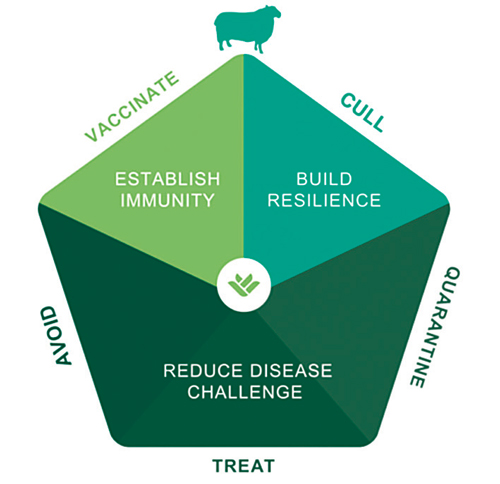4 ways to reduce sheep lameness to less than 2% by 2021
UK flocks have already worked hard to reduce lameness to less than 5% by 2016, but the next target set by the Farm Animal Welfare Committee (FAWC) is to reduce it to less than 2% by 2021.
Farmers Weekly invited farmers, vets and advisers to a roundtable discussion to find out how the industry can reach this milestone.
Below are four key challenges and suggestions for how the industry can overcome them to meet the all-important 2021 target.
See also: Sheep lameness: The successes and the remaining challenges
1. Improve farmer and vet engagement
Challenges
- Some farmers perceive the cost of vets to outweigh the cost of lameness and therefore are not engaging with their vet to help tackle lameness. Sheep farmer Anthony Warmington said: “The cheques that you don’t write are the ones that cost you money.”
- Many sheep farmers have a first point of contact with a Suitably Qualified Persons (SQP) rather than a vet.
- In some practices there are not enough vets with a special interest in sheep.
Solutions
- Practices should encourage at least one vet to gain a special interest in sheep.
- If you want a service from your vet, give them the opportunity. If they don’t respond, consider changing vet.
- Peer-to-peer learning through groups such as Farming Connect and Flock Health Clubs.
- Get SQPs to facilitate farmer and vets to talk. SQP Mark Pass from Beeston Animal Health in Cheshire runs an active sheep club together with Willows Vet Group to provide sheep farmers in the area with bespoke advice on improving health. Lameness is a key part of this and have used the Five-Point Plan to help clients reduce lameness from 20-30% to 2%.
- Vet Emily Gascoigne from Synergy Farm Health works with her clients to produce flock-specific protocols. The practice also benchmarks antibiotic consumption on each farm. She said: “Having some numbers such as antibiotic use is a starting point for a conversation about how we can manage issues on that farm.”
2. Improve lameness identification
Challenges
- A concern is farmers can become “blind” to lameness on their own farm and therefore think they don’t have an issue.
- There’s the mental challenge of trying to deal with lameness.
- Some farmers believe they will always have to tolerate a certain degree of lameness.
- Monitoring can be time consuming.
Solutions
- While mobility scoring is a well-correlated tool for identifying lame sheep, sheep specialist Fiona Lovatt says she rarely recommends farmers using it because it can “overcomplicate” lameness identification.
- Instead, we should ask fellow sheep farmers or vets to help shepherds verify lameness levels by carrying out visual observations as a group.
- Sheep farmer David Barber uses EID to record ewes that have been treated for lameness. He said: “If you don’t monitor, how can you manage?”
- Improving lameness is a self-fulfilling prophecy. Once lameness levels start dropping, spirits lift and farmers often become more finely turned at identifying lame sheep.
3. Remove the stigma around having lame sheep and foster open dialogue
Challenges
- Farmers often believe having lame sheep means they are a “poor farmer”.
- There is more of a stigma attached to having contagious ovine digital dermatitis (CODD) as there’s a belief that once it’s in a flock it can’t be cured.
- Poor public perception when seeing lame sheep.
Solutions
- Having cleared a CODD outbreak, Sarah and John Yeomans believe it is important for farmers to be open with their vet so they can help you get on top of the issue. Mr Yeomans also believes education around CODD and how you can control it will help remove the stigma.
- Encourage farmers to be open and honest with the general public about problems “warts and all”, it’s better to admit a problem and be able to at least partly control/inform the conversation.
4. Challenges of the Five-Point Plan and how to overcome them

Challenges
Culling
- Culling relies on having accurate treatment records and clearly identifying ewes.
- There’s a tendency to give ewes more chances if she has reared two good lambs or if your replacement rate is high one year.
- Studies in Texels showed genetics accounts for 18% of lameness susceptibility. Therefore, culling repeatedly lame sheep must play its part.
Quarantine
- Sheep specialist Fiona Lovatt of Flock Health said nearly half of farmers said CODD was introduced to their flocks through purchased sheep. This is a risk for lowland flocks that buy replacements annually, such as Worcestershire farmer Richard Fairbairn.
- The timing of ram sales makes it difficult to quarantine incoming stock for the appropriate length of time (one month) prior to tupping.
Treat
- Farmers still foot-trim routinely because it has “become a cycle that’s hard to break”.
- Routine foot-trimming is still taught on many university and college syllabuses.
- Kevin Harrison, sheep farmer and Scops chair-elect, believes there is confusion about using antibiotics to treat lame sheep, with some farmers believing they aren’t allowed to due to stricter regulations.
- A lack of infrastructure can hinder adequate quarantine of at least 30 days.
- Risk of disease being introduced via service providers/where equipment is being shared.
Vaccinate
- Farmers that don’t vaccinate are concerned about the human health risk in case they inject themselves accidentally; the strong immune response can cause a large lump at the injection site and the inability to use if ewes/rams have been vaccinated with Moxidectin 1%.
Avoid
- Can be difficult to avoid infection at lambing or when rotational grazing when sheep are stocked at higher density.
Solutions
- Encourage breeders to adopt lameness protocols by spreading the message through breed societies, which may be their main point of contact.
- Breeders are part of the problem and the solution and should take steps to prevent selling lameness issues to their clients, believes Mr Fairbairn.
- Understand the risk persistently infected sheep present to the rest of the flock. Dr Lovatt says these animals are “constantly shedding” infection and must be part of a holistic plan for lameness control.
- Make recording simple by using management tags or EID.
- Spend longer identifying lame sheep and don’t do too many jobs in one go at handling or you risk rushing.
- Move the ram sales so they end in August to give most of the farmers time to quarantine sheep for at least one-month before tupping.
- Encourage farmers to buy replacements direct where possible or speak to farmers to find out more about their lameness prevalence and protocols. Dr Lovatt said ideally farmers should buy from flocks operating at the same health status.
- For vaccination, use injection-proof gloves, sterimatic needles and make sure ewes are secured in an appropriate clamp for vaccination.
- Ask your vet or SQP to vaccinate the flock for you.
- Realise the risk you run if you do foot-trim sheep in spreading infection.
- Make antibiotic messaging clearer. Farmers can use antibiotics on a clinically lame sheep, but the focus should be on stopping it getting lame.
- Make sure you are using foot-baths correctly. Bad foot-bathing (dirty feet going into a clean foot-bath) is probably worse than no foot-bathing at all.
- Ensure universities and colleges are teaching the correct lameness protocols and do not champion routine foot-trimming.
- Have a set farm-specific protocol for quarantining.
- Make sure all service providers/any equipment being shared is disinfected prior to use.
Sponsor’s message

During the next few weeks, MSD Animal Health, together with Farmers Weekly, will be highlighting how the proven FAI Five-Point Plan (5PP) gives sheep farmers a clear framework for managing lameness effectively.
We will be working across the industry to provide best-practice advice and a range of practical tips.
Implemented correctly and given long-term commitment, the 5PP builds natural disease resilience within the flock, reduces the disease challenge and spread on the farm, and improves flock immunity through vaccination.
Adoption of the 5PP will maintain progress towards the industry target of achieving <2% lameness in the national flock by 2021.
Widespread adoption of the 5PP will also help reduce the amount of antibiotics used by the sheep industry by at least 10% in line with the Ruma Targets Task Force recommendations.
Further detailed advice and support is available from vet practices and SQPs in animal health trade outlets.
Thanks to MSD Animal Health, whose sponsorship made it possible to run the Sheep Lameness Roundtable 2019. Farmers Weekly had complete editorial control of this report.
